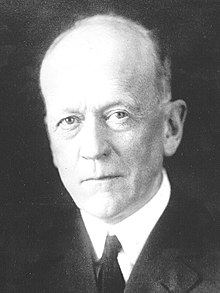Charles Doolittle Walcott
Charles D. Walcott | |
|---|---|
 | |
| Born | March 31, 1850 New York Mills, New York State, USA |
| Died | February 9, 1927 (aged 76) |
| Nationality | United States |
| Awards | Mary Clark Thompson Medal (1921) |
| Scientific career | |
| Fields | Paleontology |
| Institutions | US Geological Survey Smithsonian Institution |

Charles Doolittle Walcott (March 31, 1850 – February 9, 1927) was an American geologist and invertebrate paleontologist. He became known for his discovery in 1909 of well-preserved fossils in the Burgess Shale of British Columbia, Canada.
Walcott became Director of the U.S. Geological Survey 1894–1907, and Secretary of the Smithsonian Institution, 1907–1927. He discovered a number of important fossil sites. At the Walcott Quarry, the lowest (earliest) of the Burgess Shale deposits, Walcott collected 65,000 specimens between 1910 and 1924. The site dates to the Middle Cambrian, and is in the Canadian Rockies.[1]
The Walcott-Rust quarry is near Russia, New York. This site has produced some of the best preserved trilobites ever found, including enrolled specimens with soft body parts.
References[change | change source]
- ↑ Yochelson E.L. 1996. Discovery, collection, and description of the Middle Cambrian Burgess Shale biota by Charles Doolittle Walcott. Proceedings of the American Philosophical Society 140, #4: 469–545.
- Yochelson, Ellis L. (1998). Charles Doolittle Walcott, Paleontologist. Kent State University Press. ISBN 0-87338-599-3.
{{cite book}}:|journal=ignored (help)
